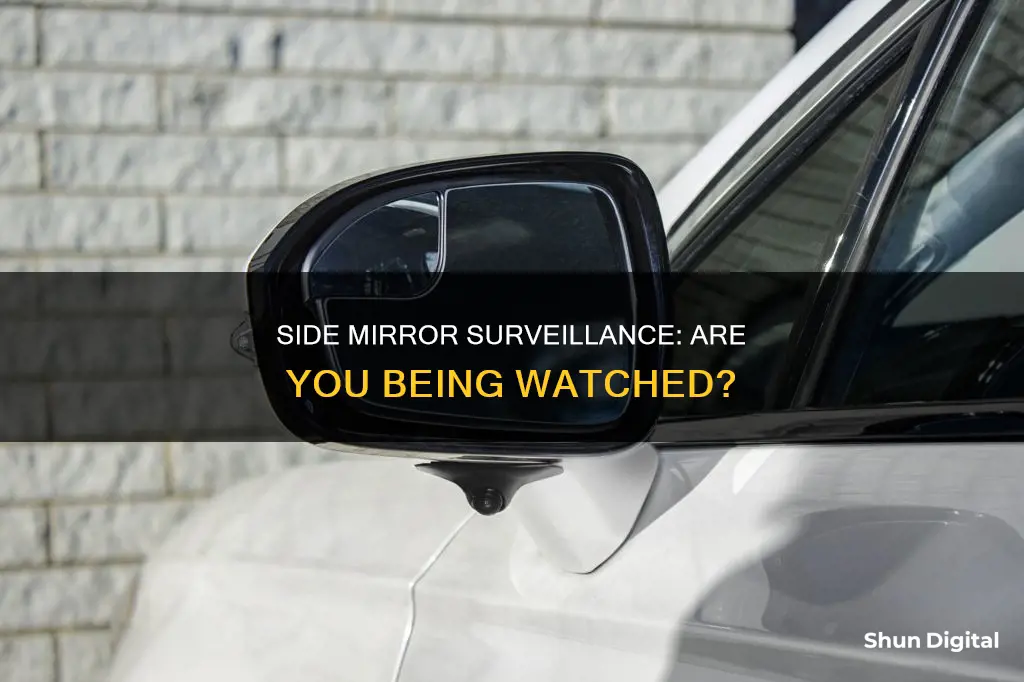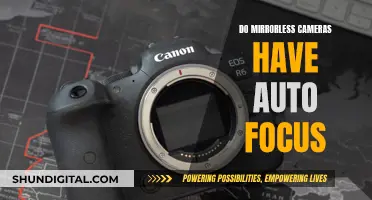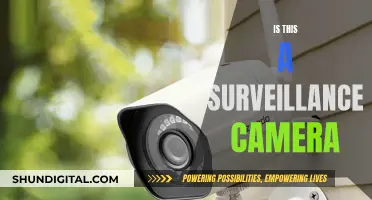
The use of cameras as side mirrors in vehicles is an emerging trend in modern car design. While this technology is not yet street legal in the US, it is available in other markets. This innovation replaces the physical side mirrors with cameras, improving aerodynamics and reducing wind noise. The cameras are affixed to thin stalks, and the live feed is displayed on screens inside the car. This technology offers several advantages, such as enhanced efficiency, improved visibility, and a more minimalistic design. However, there are also drawbacks, including higher costs, potential malfunctions, and display placement issues. The discussion around side mirror cameras highlights the ongoing evolution of automotive technology and the consideration of safety, functionality, and aesthetics.
| Characteristics | Values |
|---|---|
| Are side-view cameras street legal in the US? | No, but the National Highway Traffic Safety Administration is considering allowing them. |
| Are side-view cameras available in other countries? | Yes, they are available in Europe and Asia. |
| What are the benefits of side-view cameras? | More aerodynamic, less wind noise, improved efficiency and range, elimination of blind spots, better detail in dark places or bad weather, more minimalistic and futuristic look. |
| What are the drawbacks of side-view cameras? | More expensive, more complex and harder to replace, less reliable footage, potential distraction for drivers, inconvenient for drivers with poor eyesight. |
What You'll Learn
- Digital side-view mirror technology improves a car's aerodynamics
- Cameras can eliminate blind spots due to wide-angle lenses
- Cameras can be a safer option for drivers with poor eyesight
- Display placement inside the vehicle can be a potential distraction
- Cameras are more expensive to buy and replace than mirrors

Digital side-view mirror technology improves a car's aerodynamics
Digital side-view mirror technology is an innovative feature in the automotive industry that offers enhanced versatility, improved aerodynamics, and advanced driver assistance. This technology replaces traditional side-view mirrors with cameras that stream a live feed to displays inside the car. While this concept is not yet available in the US market due to regulations, it is offered by some manufacturers in Europe and Asia. This technology has been shown to improve a car's aerodynamics in several ways.
Firstly, digital side-view mirrors significantly enhance a car's aerodynamic efficiency by reducing drag. Traditional side mirrors create a notable drag on a vehicle's coefficient of drag figure. By replacing them with sleek cameras and slim housings, the overall drag is reduced, resulting in improved fuel efficiency and extended range. This benefit is particularly advantageous for electric vehicles (EVs) where total range is a critical factor for consumers.
Secondly, the reduced protrusion of the cameras, compared to traditional mirrors, helps decrease wind noise in the cabin. At high speeds, such as 70 mph, the smaller profile of the cameras minimizes wind resistance, leading to a quieter and more comfortable driving experience.
Additionally, the external placement of the cameras allows for a slimmer housing design. This streamlined design further contributes to the vehicle's improved aerodynamics by reducing air resistance. The slim housing also enhances the driver's outward visibility, especially at junctions or intersections, making it easier to navigate through complex traffic situations.
Moreover, the digital side-view mirror technology can be adjusted to suit different driving scenarios. For example, during highway driving or when indicating, the cameras can zoom out to provide a wider field of view, minimizing blind spots and making lane changes safer. On the other hand, when parking, the cameras can zoom in to offer a more precise view of adjacent vehicles and surrounding obstacles.
The versatility of the digital side-view mirror technology not only improves aerodynamics but also enhances the overall driving experience and safety. The ability to adjust the field of view dynamically ensures that drivers have the necessary visual information to make informed decisions and maneuver their vehicles with confidence.
While digital side-view mirror technology offers these aerodynamic benefits, it is important to consider potential drawbacks, such as the shift in perspective when glancing at the screens and the learning curve associated with adjusting to the new system. However, as the technology evolves and becomes more prevalent, these issues may be addressed through improved design and driver familiarity.
Land Camera's First Steps: What Made It So Popular?
You may want to see also

Cameras can eliminate blind spots due to wide-angle lenses
While side mirrors in vehicles do not typically have surveillance cameras, adding cameras to side mirrors can help eliminate blind spots.
A blind spot is any area that is not within the peripheral vision of an installed security camera. All cameras have a limited range, and a single camera placed in one position is not enough to monitor an entire property. Similarly, standard rearview mirrors in vehicles have limited fields of view and cannot show vehicles in the side or rear blind zones.
Blind spots in vehicles can be eliminated by installing a camera system that uses a wide-angle lens to provide a broad view of the vehicle's surroundings. The captured scenes are then shown on a monitor or infotainment screen within the car's interior.
When choosing a blind spot camera system for your vehicle, it is important to consider the following:
- A wide field of view: Look for a system with a 140-180 degree field of view to maximize visibility. A panoramic view without gaps ensures that all areas around the vehicle are visible.
- Monitor or screen: Choose a model that uses your existing infotainment screen or has a dedicated monitor. Touch screens allow you to move the camera feed for optimal viewing.
- Easy installation: Look for systems with adhesive or license plate mounting options that do not require drilling. This makes installation easier and reversible.
- High resolution: Higher resolution cameras (1080p or 4MP) capture sharper video with more detail, providing better clarity and easier identification of objects.
- Night vision: Cameras with night vision capability (via infrared or Sony Starvis sensors) enhance visibility in low-light conditions.
- Weatherproofing and warranty: Ensure the cameras are IP67 or IP69K rated waterproof and designed for harsh road conditions. Opt for systems with at least a 1-year warranty, with longer warranties being preferable.
By installing a blind spot camera system with these features, you can effectively eliminate blind spots and improve safety while driving.
Calibrating Camera Focus: The Paper Test
You may want to see also

Cameras can be a safer option for drivers with poor eyesight
Digital side-view mirror technology replaces the physical mirrors on either side of a car with cameras. While this technology is available in Europe and Asia, it is not yet permitted in the US.
In addition to safety benefits, digital side-view cameras offer improved aerodynamics and reduced wind noise. However, there are also drawbacks to this technology. For example, the shift in perspective when looking at in-cabin screens can be disorienting and require greater focus, taking the driver's eyes off the road for longer. Furthermore, the inability to adjust the viewpoint or quickly glance at a wider field of view can be limiting, especially in congested or rapidly changing traffic situations.
While digital side-view cameras offer certain advantages, it is important for drivers to carefully consider their potential benefits and drawbacks, especially in relation to individual needs and preferences.
Mastering Camera Focus: Measuring Techniques for Photographers
You may want to see also

Display placement inside the vehicle can be a potential distraction
Digital side-view mirror technology replaces the physical mirrors on either side of a car with cameras affixed to thin stalks. The live camera feed is then displayed on screens placed on either side of the car, in the same area one would usually look to find a traditional mirror. While this technology has its benefits, such as improved aerodynamics and reduced wind noise, it also introduces potential distractions for the driver.
The placement of displays inside the vehicle can be a significant distraction for drivers. According to the National Highway Traffic Safety Administration (NHTSA) and the Virginia Tech Transportation Institute (VTTI), driver distractions are the leading cause of most vehicle collisions and near collisions. Their study found that 80% of crashes and 65% of near crashes involved some form of driver distraction, with the distraction occurring within 3 seconds before the incident.
One of the main issues with digital side-view mirrors is the shift in perspective that drivers experience when looking at the in-cabin screens. The spatial perception that drivers have developed over years of using traditional mirrors is no longer applicable with camera side mirrors. Determining the distance, closing speed, and relative position of other vehicles on a screen requires a higher level of focus and can be disorienting. This can lead to longer glances at the screens, taking the driver's eyes off the road for extended periods, increasing the risk of accidents.
Additionally, the lack of adjustability in camera side mirrors can be a hindrance. With traditional mirrors, drivers often make subtle head movements to get a slightly different view, such as during lane changes or merges. However, with camera mirrors, the field of view is fixed, and any change in perspective requires a full turn of the head, reducing reaction time and increasing the likelihood of missing potential hazards.
To mitigate the potential distractions caused by display placement, drivers should be aware of the following:
- Adjust vehicle controls, including mirrors, before starting the trip. Make use of stops along the way to make any necessary adjustments.
- If possible, ask a passenger to assist with adjusting controls or operating the navigation system.
- Avoid making frequent adjustments to the displays or controls while driving to minimize visual and manual distractions.
- Ensure that the displays are properly positioned and angled to minimize the shift in perspective when glancing at them.
- Familiarize yourself with the vehicle's controls and functions before driving to reduce the need for frequent adjustments.
- If the displays cause significant distraction, consider traditional mirrors as a safer alternative, especially if you frequently drive in challenging or congested traffic conditions.
Focus Red Lines Camera: How Does It Work?
You may want to see also

Cameras are more expensive to buy and replace than mirrors
Digital side-view mirror technology is yet to make its way into the US market due to current vehicle regulations. However, it is already available in Europe and Asia. These digital side mirrors replace the physical mirrors on either side with cameras that are affixed to thin stalks protruding from the same area as a typical mirror. While these cameras offer some undeniable benefits, they also come with certain drawbacks.
One of the main drawbacks of digital side-view mirrors is the cost. Cameras are generally more expensive to buy and replace than traditional mirrors. This is especially true for high-quality cameras that can provide a clear view and offer features such as night vision and distance sensors. The cost of installation also needs to be considered, as cameras typically require professional installation, unlike mirrors which can be installed by anyone in just a few minutes.
Another consideration is the power source. Cameras need to be wired into the vehicle's electrical system, which can be another potential cost if you don't have the necessary skills or knowledge. In contrast, rear-view mirrors do not require any additional power source, making them more cost-effective and easier to maintain.
Additionally, digital side-view cameras can be disorienting for drivers. The shift in perspective when looking at the in-cabin screens can be jarring and require more time to adjust. The lack of ability to adjust the point of view is also a limitation, as drivers are restricted to the camera's fixed angle. This can be inconvenient in situations with changing traffic or congested merges, where a quick glance in a traditional mirror would suffice.
While digital side-view cameras offer advantages such as improved aerodynamics and reduced wind noise, the higher cost and installation requirements make them a more expensive option than traditional mirrors. For those seeking the cheapest option or a simple solution, traditional mirrors remain a reliable and cost-effective choice.
Charging Your Vivitar Camera: A Step-by-Step Guide
You may want to see also
Frequently asked questions
Some vehicles have replaced traditional side mirrors with cameras. This feature is available in Europe and Asia but is not yet street legal in the US. Vehicles with this feature include the Audi e-tron, Honda E, and Hyundai Ioniq 5.
Side mirror cameras improve aerodynamics and reduce wind noise, resulting in increased vehicle range. They also eliminate blind spots and provide better visibility in low-light conditions or bad weather. Additionally, they offer a more minimalistic and futuristic design.
Side mirror cameras are more expensive and complex than traditional mirrors, making them more prone to malfunction and challenging to replace. They may also provide grainy or blurry footage, especially in poor lighting or bright sunny conditions due to lens flare. The placement of the display inside the vehicle can be a potential distraction, and they may be inconvenient for drivers with poor eyesight or those wearing bifocals or progressive lenses.







